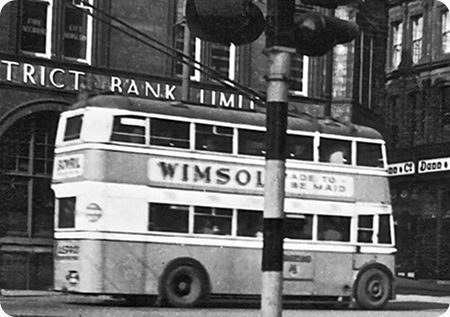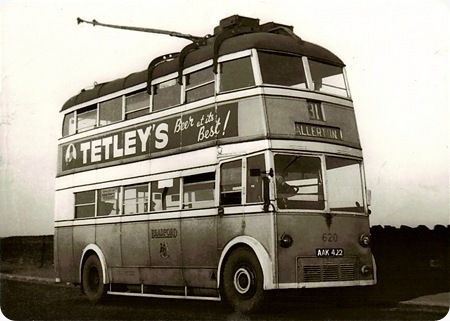Bradford Corporation – AEC 661T – AAK 422 – 620
Bradford Corporation Transport
1935
AEC 661T
English Electric H32/26R
We all have our personal favourites as far as buses are concerned, and I have to confess that mine are, (or were), trolleybuses.
Amongst my earliest memories were the late war years in Bradford, where I so clearly recall the sight, and sound, of Bradford`s “Regen” trolleybuses.
These were AEC 661T types based at my home depot of Duckworth Lane, and were unlike any trolleybuses anywhere else, as they made a NOISE. Their mournful wail could be heard for miles about, especially when braking, and this was due to the double reduction rear axle and full regenerative control. How Bradfordians distinguished them from the Air Raid “all clear” signal I shall never know!
They were new in 2 batches, in 1934 (597-617 KY 8200-8220) and 1935 (618-632 AAK 420-434), and carried early examples of English Electric metal framed bodies, which recent research has discovered, were extremely troublesome right from the off. English Electric metal bodies at that time did not benefit from the expertise demonstrated in the products of Metro Cammel. Having said that, the situation was not helped by tight and hilly schedules, the aforesaid unusual double reduction rear axles, and the fully regenerative control, such that these bodies were virtually shaken to bits after a troublesome 10 year life on Bradford`s granite setts.
Failures were occurring at an alarming rate by the war years, and BCT received permission to rebody 9 of them with Brush utility bodies in 1944, during which process, the regenerative control was reduced. The remainder were rebodied by Northern Coachbuilders in 2 styles, between 1946 and 1949, the last of the English Electric all metal bodies being consigned to scrap in 1947, and these trolleybuses, with their composite bodies, then settled down to a “second life” which was to last into the 1960s.
They still made plenty of noise in their new guise and being a regular rider to school, each one developed its own character for me, and they became firm friends. Sad, I know!

I attach a poor quality Brownie Box photo of 606, one of the Brush rebodies, and always my favourites, taken on a quiet 1953 Sunday morning. This photograph is full of nostalgia for me, especially as it was one of the last to carry the older Tattam livery with cream bands and rear dome.
Happy Days! If only I could ride on one again at Sandtoft!
Photographs and Copy contributed by John Whitaker
Bus tickets issued by this operator can be viewed here.
———
Not sad at all – some vehicles, just like people, have characters and the more eccentric ones get recalled the most! How amazing that permission was given to re-body vehicles while the war was on, something I’ve not previously heard of.
I always had a soft spot for the London United Tramways (later LT) A1 and A2 class ‘Diddler’ trolleybuses, unique and also frail bodywise!
Chris Hebbron
———
Fear not John, as Chris H rightly says there’s nothing sad in being fortunate enough to be able to recognise the characteristics of vehicles. It is a fact that, even in large batches of brand new ones, individual machines very quickly display their own particular "natures." As a teenager on frequent visits to relations in South London I was also totally fascinated by the "Diddlers" on outings to Hampton Court and the area.
Chris Youhill
———
Thanks Chris H and Chris Y for the reassuring remarks about my deceased friends!! Good to know that other enthusiasts are just as moved as myself when referring to man-made inanimate objects !!
Thanks for comments about London "Diddlers" from Chris Y and Chris H. I too was fascinated by them, but never saw them "in the flesh". I hold my very fleeting memories of Bradfords EEC 6 wheelers, and single deckers in the same light, as I can only just remember them. It would be great to hear about other trolleybus interests from fellow enthusiasts, as my enthusiasm is for anything old in the psv line, including trams!
But I wont go there!
John Whitaker
———
Chris Hebbron raises an interesting point re. re-bodying of vehicles during WW2. The MOWT (Ministry of War Transport) controlled all allocations of chassis and body manufacture, and supply to customers. I doubt whether operators had much say in most cases; Body builders were allocated orders in batches, and hence Pickering, for example, built small numbers of utility bodies in 1942/3 on unfrozen, and early Guy Arabs, (including a minority on Mk2 chassis), they disappeared again until late 1945, when they were allocated a contract for relaxed single deck utility bodies on Albion chassis, for Scottish operators.
East Lancs were used for re-bodying only, several fleets receiving all metal bodies on reconditioned chassis (mainly AEC) to almost peacetime standard. Brush were unusual, but not unique, in being used for new and reconditioned chassis, viz the Bradford trolleybuses and early AEC Regents for Birmingham. Bradford had 10 AEC Regents with all metal English Electric bodies which dated from 1935/6, and these were just as worn out as their trolleybus cousins by 1944, such that 7 were given new East Lancs bodies that year. I intend to look at the English Electric situation as far as metal framed bodies are concerned, as there were other disasters, notably with a batch of TD3/TD3c buses for Burnley Colne and Nelson JTC. I will submit a post on the subject if there is sufficient interest.
John Whitaker
———
I was delighted to see the Bradford AEC 661T "Regens" 620 and 606 posted on this web site by my best friend John. These were my favourite group of trolleybuses as they made a loud noise and had regenerative braking. Over the last few years I have been doing research into the early years of these trolleybuses 597 to 632 built 1934/35. My findings have been published in the Journal of the Bradford Trolleybus Association "Trackless" 200 to 205 inc. and 211. I can confirm the double reduction differential rear axle drive and the fierce regenerative braking were the main contributory factors leading to the failure of their EEC metal-framed bodies. The noise and vibration made it impossible for passengers to have a conversation inside these trolleybuses when running at speed, such as from Springhead Road to Bell Dean Road on the Thornton route. This leads me to ponder why Bradford specified a double reduction differential drive when a single worm drive differential was working quietly and efficiently on a very similar AEC 661T/EEC in London, namely LTPB 63 delivered some months earlier.
Richard Fieldhouse
———
This site has certainly brought back some memories.
I served an apprenticeship with the English Electric Co. at the Thornbury works in Bradford in the late 50’s. The Trolleybus motors kept the Traction Department busy for many years.
I recall working on the motors in both production and refurbishment and for it’s output it was very compact, good for it’s purpose, but a pain to work on. A common fault with motors returned for Overhaul was the "Square Commutator" Not really square but appearing so due to abnormal wear on opposite sides. Caused it turned out by slightly eccentric brake drums on some vehicles resulting in the motors always stopping and starting at the same point in it’s rotation.
Phil Johnson
———
Amazing the sort of problems which crop up – I should think it required some thinking about to identify THAT problem!
Chris Hebbron
———
I found Phils’ comments and experience at the English Electric Co at Thornbury most interesting and wonder which type of trolleybus traction motors were being overhauled and who were the regular customers. Can I assume Bradford City Transport was a regular as it was a loyal supporter of English Electric traction equipment?
Richard Fieldhouse
———
19/04/11 – 19:20
In the comments on the page for Bradford Corporation AEC661T trolleybuses, some correspondents mention the LUT "Diddler" trolleybuses. In 1962 the last trolleybuses were withdrawn in London and living in a road near the last trolleybus route to close I took my 18 month old son to see the last trolleybus from Hammersmith to the depot at Fulwell. In the event the modern bus was preceded by a "Diddler" from the London Transport Museum decorated with bunting, etc. as for its opening day. Alas, my son does not recall the sight.
For those of you who are interested, if you log on to the "You Tube" website and type in the Search Box "Twickenham Trolleybuses" (without the quotes) there is a film of the first day of operation of the diddlers taken in 1932. It is in black and white and, originally, was silent but a sound track of 1930’s band music has been added.
If you look carefully you will notice that they do not have headlights but it was shortly afterwards at the insistence of the police that a single headlight was put in the centre of the panel replacing the radiator on a IC engined bus.
Phi Jones
——— Top of this posting ———
Quick links to the - Comments Page - Contact Page - Home Page
Please leave a comment
Please Note if you want to send a photograph with your comment please use the Contact Page by clicking here or send as an attachment via email.

